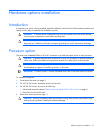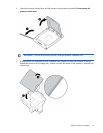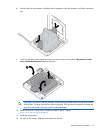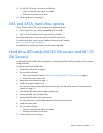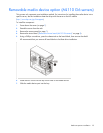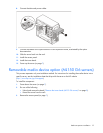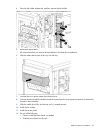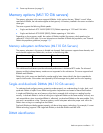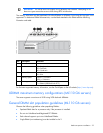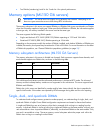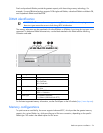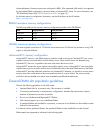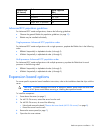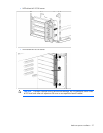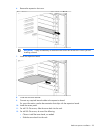
Hardware options installation 21
13.
Power up the server (on page 7).
Memory options (ML110 G6 servers)
The memory subsystem in this server supports UDIMMs. In this section, the term "DIMM" is used. When
specified as UDIMM, the information applies to that type only. All memory installed in the server must be the
same type.
The server supports the following DIMM speeds:
• Single- and dual-rank PC3-10600E (DDR-1333) DIMMs operating at 1333 and 1066 MHz
• Single- and dual-rank PC3-8500E (DDR3), DIMMs operating at 1066 MHz
Depending on the processor model, the number of DIMMs installed, the memory clock speed may be
reduced to 1066 or 800 MHz. For more information on the effect of DIMM slot population, see "General
DIMM slot population guidelines (on page 25)."
Memory subsystem architecture (ML110 G6 Servers)
The memory subsystem in this server is divided into channels. Each processor supports three channels, and
each channel supports two DIMM slots, as shown in the following table.
Channel Slot Slot number
1
C
A
1
2
2
D
B
3
4
This multichannel architecture provides enhanced performance in Advanced ECC mode. The Mirrored
Memory and the Lockstep Memory modes are not supported in this architecture. This server supports both
RDIMMs and UDIMMs.
DIMM slots in this server are identified by number and by letter. Letters identify the slots to populate for
specific AMP modes. Slot numbers are reported by ROM messages during boot and for error reporting.
Single- and dual-rank DIMMs (ML110 G6 servers)
To understand and configure memory protection modes properly, an understanding of single-, dual-, and
quad-rank DIMMs is helpful. Some DIMM configuration requirements are based on these classifications.
A single-rank DIMM has one set of memory chips that is accessed while writing to or reading from the
memory. A dual-rank DIMM is similar to having two single-rank DIMMs on the same module, with only one
rank accessible at a time. A quad-rank DIMM is, effectively, two dual-rank DIMMs on the same module. Only
one rank is accessible at a time. The server memory control subsystem selects the proper rank within the
DIMM when writing to or reading from the DIMM.
Dual-rank DIMMs provide the greatest capacity with the existing memory technology. For example, if current
DRAM technology supports 2-GB single-rank DIMMs, a dual-rank DIMM would be 4-GB.
DIMM identification



